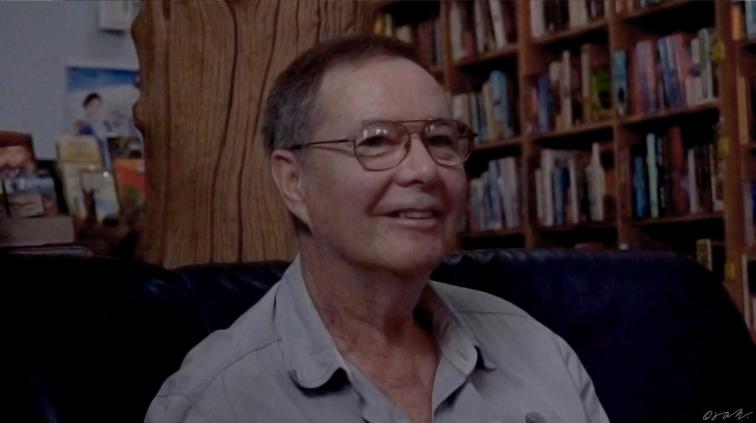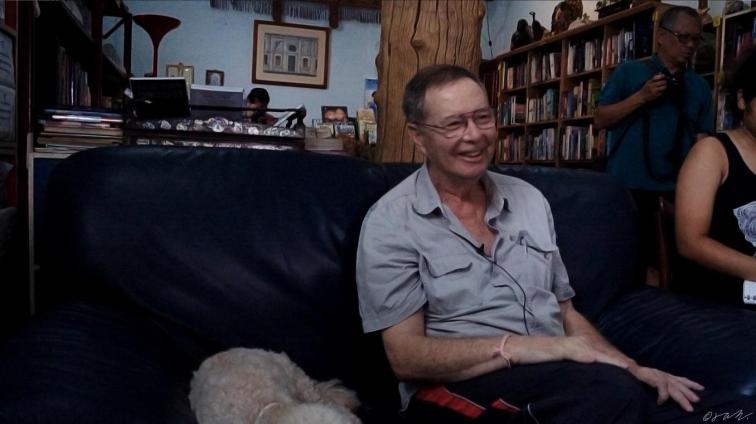Words by Madhavi Mehndiratta
Photos by Sitwat Hashmi
With every passing day approaching the end of the study trip, the student travellers gathered at a nearby book café in Vientiane to attend the last session delivered by Dr. Robert Cooper. In this session, Dr. Cooper gave a broad overview of Laos’s history and its different ethnic groups whilst sharing his knowledge based on personal experience in contemporary Laos.
Dr. Cooper lectured about economic anthropology at the University of Singapore from 1977 until 1980, after which he joined the United Nations High Commissioner for Refugees to serve in Laos. As a professor in University of Singapore, he taught anthropology to a batch comprising of 50 students from second year followed by 20 students from third and fourth year respectively. Moreover, he worked with Lao and Thai authorities as well as the Hmong ethnic group, for whom he planned and introduced the voluntary repatriation programme to those who wished to return to Laos.
Presently, he owns and manages Book-Café – a publishing house and bookshop specialising in information on Laos. Additionally, the outlet translates and publishes Lao books in English. It is one of the largest bookshops to distribute maps and books on Laos in outlets within Laos, including three international airports.

During the session, Dr. Robert Cooper broadly outlined topics such as identification of the diverse ethnic groups in Laos, religion in the country, exploitation of Thai sex traffickers moving from Bangkok to Laos and also Laotians moving to America in search of better work opportunities.
Identification of Diverse Ethnic Groups
Laos is a landlocked Southeast Asian country surrounded by Myanmar and China to the northwest, Vietnam to the east, Cambodia to the south and Thailand to the west. A land in between, the multi-ethnic people of Laos are generally scattered around the country. However, each ethnicity has managed to preserve its own unique tradition, culture and language. Despite its small population, Laos has no fewer than 49 ethnic groups. As there are so many ethnic groups, the Lao traditionally divide themselves into three categories – Lao Lum, Lao Thoeng and Lao Soung – the Lao Lum, also known as Lowland Lao, makes up 60% of the total population and are based mainly on the Mekong River and other waterways; the midland and highland Lao (Lao Thoeng), which comprise about 20% of the population, generally live at elevations from 300 to 1200 meters and speak a Mon-Khmer language; and finally the hill tribes (Lao Soung) which makes up 15% of the population and generally live at elevations above 1000 meters. Within the interethnic groups, the way people self-identify ethnically is often contextual. As Robert Cooper argues, it is not easy to identify people in Laos based on ethnicity even though they speak a common language which is expressed and understood by people differently. Despite the dispersed multi-ethnic groups, people live together in peace and no ethnic group has ever exploited or conquered another in recent history. Each ethnic group has a common character of being part of a unified nation while upholding its own particularities. As Dr. Cooper said during the session – “People are tolerant and respectful of each other.”
Religion
According to Dr. Cooper, “The Constitution provides for freedom of religion and allows every individual a right to choose, change or interpret their religion.” Almost all Lao Lum are followers of Theravada Buddhism, while the remainder of the population are ethnic minorities and are practitioners of animism – providing a point of unity between all ethnic groups within Laos. This is because of the common system of beliefs and values of Buddhism and animism, which unites the two religions in sharing a common bond. Lacking a religion shared on a national basis, animism provides a common point between some 31% of Lao who state they have ‘no religion’, the 67% who see themselves as Buddhist and the various small religion minorities.

Exploitation of Thai Sex Traffickers Moving from Bangkok to Laos
Dr. Cooper also spoke about a large number of Thai sex workers who moved from Bangkok to Vientiane prior to 1975, the year the new communist regime was instilled, in order to make money in the sex trade. While some children and women were forced to become prostitutes through sex trafficking, others seemed to want to remain in the sex industry due to the economic stability it provided them. Towards the end of 1975 however, the bars and brothels were shut down and this red light district was used by the new regime to provide shelter to homeless children and families in Vientiane. While the place was utilized for a good cause, the sex traffickers were deported to acquire skills in the educational institutes in two secluded islands – Girl’s and Boy’s Island. The girls and women in Girl’s Island were taught needlework while the boys and men in the Boy’s Island were taught to repair bicycles. These gender based skills were aimed to build a better future by the government. Despite the implementation of government incentives, the boys and girls returned back to pursue their career in sex trafficking because it was the only source of income which needlework and bicycle repair had failed to provide.
Laotians Moving to America in Search of Better Work Opportunities
Dr. Cooper declares, “Laos is increasingly becoming rich in economic diversity as large populations of people are moving to different countries with more vibrant economies and better job opportunities.” After 1975, thousands of Laotian immigrants obtained American visa from the Lao embassy and moved to America in search of better work opportunities. Upon arrival, they applied for lawful permanent residence in the United States (also known as receiving a ‘green card’) and qualified as family-sponsored immigrants or as immediate relatives of U.S. citizens. Vast majority of Laotians who immigrated to the United States were unaccustomed to an industrial society and spoke very little or no English and migrated to urban areas in the U.S. where they could find work that did not require skills or language proficiency. The unsettled returnees built shops in Vientiane to earn a livelihood in the vicinity.
Throughout most of the modern era, Lao economy has been in a transitional phase and its continued evolution towards free market economy, which opens its doors to international competition, is likely to be slow. There are several reasons for this, but the principal ones are political and structural deficiencies. The weakness of the Lao economy in meeting the development needs of the country is related to the reluctance of the government to enforce taxation law. The resultant low revenue collection provides the government with only limited means to address severe problems of poverty, inequality, gender disadvantage, poor provision of services and poor development of human resources. Furthermore, it does not have the means to undertake or maintain infrastructural development projects. Thus, the result is a distorted market economy marred by weak financial institutions, uneven competition, poor transparency and political inefficiency sapped by pervasive corruption.
A patriotic Indian by heart, Madhavi loves to dress in her Bollywood attire and arbitrarily dance to loud music.
